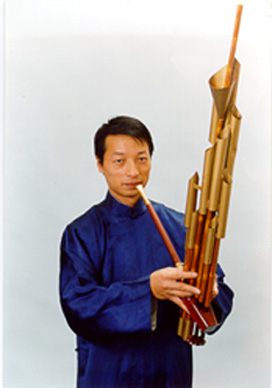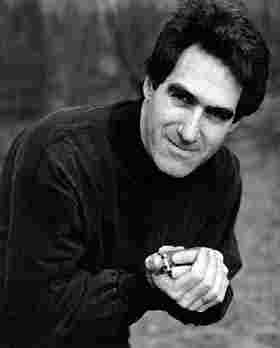
The first performer, Wang Zheng Ting, * is a graduate of the Shanghai Conservatory and holds an M.A. degree in Ethnomusicology from Monash University in Australia. He is the founder and director of the Australian Chinese Music Ensemble and has actively promoted Chinese music throughout that country. His 1997 U.S. tour included both lectures at various universities and the premiere in Minnesota of his Concerto for Sheng, commissioned by the American Composers Forum. Mr. Wang is presently pursuing the Ph.D. in Ethnomusicology at the University of Melbourne.
This was the first time I had seen and heard a sheng in person, as was the case also for most of the 200 or so audience members in the intimate auditorium. I had done some research on the sheng while writing my book, The Classical Squeezebox, and so I knew that the sheng was the ancestor of all the western free-reed instruments.
- "The evolution of
the accordion began in China, sometime during the third millennium B.C.,
with the sheng -- literally "sublime voice" -- which is the earliest known
example of a free-reed instrument. According to oral tradition it was
invented by the female sovereign Nyn-Kwa in 3000 B.C. The sheng had a
gourd as a wind-chamber and thirteen to twenty-four bamboo pipes. At the
base of each pipe a tongue was cut in such a way as to vibrate freely when
the player blew into the instrument through the mouthpiece and covered the
hole in the side of a pipe with a finger. The sheng was formed to imitate
the shape of the Phoenix bird and it is probably because of this tradition
that it is still used today in China for funeral processions."
Wang's sheng is not an unsophisticated instrument by any means; it has a great range in pitch and dynamics. The reeds are made from copper and there are even keys, similar to the keys of a flute or clarinet, which increase the range of pitches available to the player.
I discovered while listening to Wang play that the sheng has an incredibly wide dynamic range, from blasting chord sforzandos to barely audible single-note whispers. One characteristic feature of Phownix Spreads Its Wings was a fortissimo chord followed by a pianissimo sustained tone. The melodies and harmonies appeared to be based on a pentatonic scale, one characteristic of much oriental music.
The second piece, Spectre, composed by Wang, was accompanied at times by a pre-recorded tape which sometimes sounded like thunder, and other times like Tibetan monks' chants. Spectre is a programatic piece, based on the traditional fire-and-brimstone description of hell. The piece, unlike the other works during this part of the program, was dissonant, beginning with the harmonic interval of a minor second. Wang's composition did seem to portray the anguish of a soul lost in hell.
Wang's final piece, Lusheng Harvest Song, was played on the lusheng, a less sophisticated folk sheng indigenous to many of the ethnic minorities of Southwest China.
Wang played both instruments with precision, clarity and expression, and included such unusual techniques as tremolo, glissandi (bending notes up to a minor third), and humming while playing. I especially enjoyed the two voice polyphonic sections. Since the sheng is a two-handed instrument, each hand can play its own independent melodic line.
It was interesting to watch Wang "warm up" his instrument by pouring a cup of hot water inside it, in a specially designed chamber expressly made for that purpose! Warming up the instrument in this way prevents condensation from the player's breath from forming in the pipes and reeds which might cause the instrument to go out of tune, or perhaps even corrode the copper reeds.
My only complaint: the sheng is so huge that it completely masks the performer's face! I could not see Wang's facial expressions!
The second performer, Richard
Hunter (http://www.rootsworld.com/hunter), was a familiar name to me as I heard his first CD, The Act of Being Free In One
Act, which was reviewed in the pages of The Free-Reed Review. Hunter performed
all the works on his part of the program -- with the exception of Duke
Ellington's In A Sentimental Mood -- on the diatonic harmonica.
Normally one does not associate the diatonic harmonica, an instrument which can only play the notes of a major (or natural minor) scale in one key, with anything except simple melodies and chords. (Classical composers who wrote for the harmonica, such as Ralph Vaughan Williams and Heitor Villa-Lobos, wrote for the chromatic harmonica.) Hunter showed us otherwise, however, as several of the works he performed, such as Billy the Kid, Bela's World (a tribute to Bela Bartok mildly reminicent of Mikrokosmos), and Requiem, amazingly featured two simultaneous independent voices.
Hunter uses the technique of blocking out a good many reed holes with his tongue, thereby allowing only the two outside tones to sound with a range of a tenth or more. Such artistry on the seemingly simple diatonic harmonica was surprising as well as satisfying! His compositions for solo harmonica were not lacking in any respect, harmony, rhythm or counterpoint. **
I congratulate my colleague Allan Atlas, founder and director of The Center for the Study of Free-Reed Instruments, for organizing this concert, and I look forward to next year's concert and masterclass.
* Mr. Wang Zheng-Ting can be contacted at:
6/83 Denham St
Hawthorn Vic
Australia 3121
tel & fax: (613) 94294082
email: wangzheng-ting@iname.com
** Richard Hunter wrote:
Date: Sat, 13 Mar 1999 12:48:48 -0500
From: Richard Hunter -- richard.hunter@snet.net
Subject: Mouth Organs East and West Review
Henry,
I enjoyed the review of the "Mouth Organs East and West" concert, and will post a link to it from my site. Examples of the split tonguing technique which I use to perform counterpoint in real time can be found in recordings by Larry adler, Blackie Shackner, and others, and I believe that the technique dates back at least to the 1930s. I believe that I am the first composer to incorporate this technique into compositions for the diatonic harmonica, and I am certainly the first to stretch the counterpoint out to two full octaves.
| About The Free-Reed Review |
| Invitation to Contributors / Submission Guidelines |
| Back to The Free-Reed Review Contents
Page |
| Back
to The Classical Free-Reed, Inc. Home Page |
